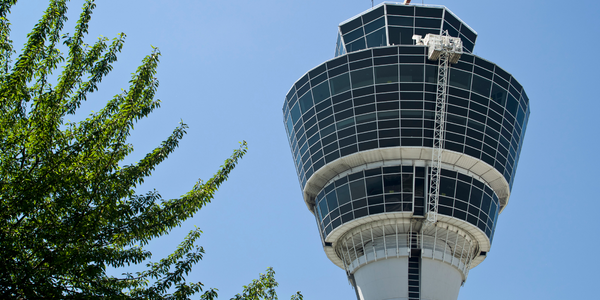Transforming Data Accessibility and Analytics for Government Agencies: A Case Study on Socrata and AWS
---nasdaq--amzn_14.jpg)

Technology Category
- Functional Applications - Transportation Management Systems (TMS)
- Platform as a Service (PaaS) - Application Development Platforms
Applicable Industries
- Cities & Municipalities
- Transportation
Applicable Functions
- Logistics & Transportation
- Quality Assurance
Use Cases
- Autonomous Transport Systems
- Time Sensitive Networking
Services
- Cloud Planning, Design & Implementation Services
- Testing & Certification
The Customer
Socrata
About The Customer
The Utah Department of Transportation (UDOT) is a government agency responsible for the construction and maintenance of public transportation infrastructure in the state of Utah. UDOT was struggling with data accessibility and analytics due to limited access to their business intelligence software. The organization needed to consolidate different systems and provide more people with access to information and basic analytic tools. This was particularly important as UDOT relied on updated data to secure funding for projects from the state legislature. UDOT became a customer of Socrata, seeking a solution to their data accessibility and analytics challenges.
The Challenge
Socrata, an Advanced Technology Partner in the AWS Partner Network (APN), often encountered customers struggling to unlock data from siloed, difficult-to-access systems and put it into a self-service accessible platform. This was crucial for strategic use of data in delivering program outcomes. A prime example was the Utah Department of Transportation (UDOT), a Socrata customer, which had difficulty using data and analytics in its daily work due to limited access to their business intelligence (BI) software. Only a small group of employees had access to the BI tool, leading to delays in simple tasks like changing a color on a graph. UDOT needed to consolidate different systems and provide more people with access to information and basic analytic tools. This was particularly important as UDOT relied on updated data to secure funding for projects from the state legislature.
The Solution
Socrata migrated its platform from Microsoft Azure to Amazon Web Services (AWS) in 2016, attracted by the elasticity and scalability of AWS. This allowed their engineering team to focus more on developing new solutions. The Socrata platform now runs on 172 Amazon Elastic Compute Cloud (Amazon EC2) instances and stores platform data in the Amazon Simple Storage Service (Amazon S3). To address customer compliance requirements, Socrata worked with AWS to support FedRAMP certifications, achieving the FedRAMP Moderate Authority to Operate (ATO) certification in 2017. To help UDOT, Socrata collaborated with technology integrator and consulting firm Grant Thornton to consolidate data from 15 of UDOT’s business systems into Socrata’s cloud-based platform. The platform was configured and operational in six weeks, with continuous value addition every two weeks on an AGILE sprint schedule.
Operational Impact
Quantitative Benefit

Case Study missing?
Start adding your own!
Register with your work email and create a new case study profile for your business.
Related Case Studies.

Case Study
Turning A Stadium Into A Smart Building
Honeywell created what it called the “intelligent system” for the National Stadium in Beijing, China, turning the venue for the opening and closing events at the 2008 Summer Olympics into a “smart building.” Designed by highly controversial artist Ai Weiwei, the “Bird’s Nest” remains one of the most impressive feats of stadium architecture in the world. The 250,000 square meter structure housed more than 100,000 athletes and spectators at a time. To accommodate such capacity, China turned to Honeywell’s EBI Integrated Building Management System to create an integrated “intelligent system” for improved building security, safety and energy efficiency.
.png)
Case Study
Smart Street Light Network (Copenhagen)
Key stakeholders are taking a comprehensive approach to rethinking smart city innovation. City leaders have collaborated through partnerships involving government, research institutions and solution providers. The Copenhagen Solutions Lab is one of the leading organizations at the forefront of this movement. By bringing together manufacturers with municipal buyers, the Copenhagen Solutions Lab has catalyzed the development and deployment of next-generation smart city innovations. Copenhagen is leveraging this unique approach to accelerate the implementation of smart city solutions. One of the primary focus areas is LED street lighting.

Case Study
Airport SCADA Systems Improve Service Levels
Modern airports are one of the busiest environments on Earth and rely on process automation equipment to ensure service operators achieve their KPIs. Increasingly airport SCADA systems are being used to control all aspects of the operation and associated facilities. This is because unplanned system downtime can cost dearly, both in terms of reduced revenues and the associated loss of customer satisfaction due to inevitable travel inconvenience and disruption.

Case Study
IoT-based Fleet Intelligence Innovation
Speed to market is precious for DRVR, a rapidly growing start-up company. With a business model dependent on reliable mobile data, managers were spending their lives trying to negotiate data roaming deals with mobile network operators in different countries. And, even then, service quality was a constant concern.

Case Study
Buoy Status Monitoring with LoRa
The Netherlands are well-known for their inland waterways, canals, sluices and of course port activities. The Dutch Ministry of Infrastructure indicates that there are thousands of buoys and fixed items in and near water environments that would profit from IoT monitoring. One of the problems with buoys for example, is that they get hit by ships and the anchor cable breaks. Without connectivity, it takes quite some time to find out that something has happened with that buoy. Not to mention the costs of renting a boat to go to the buoy to fix it. Another important issue, is that there is no real-time monitoring of the buoys at this moment. Only by physically visiting the object on the water, one gains insight in its status.



